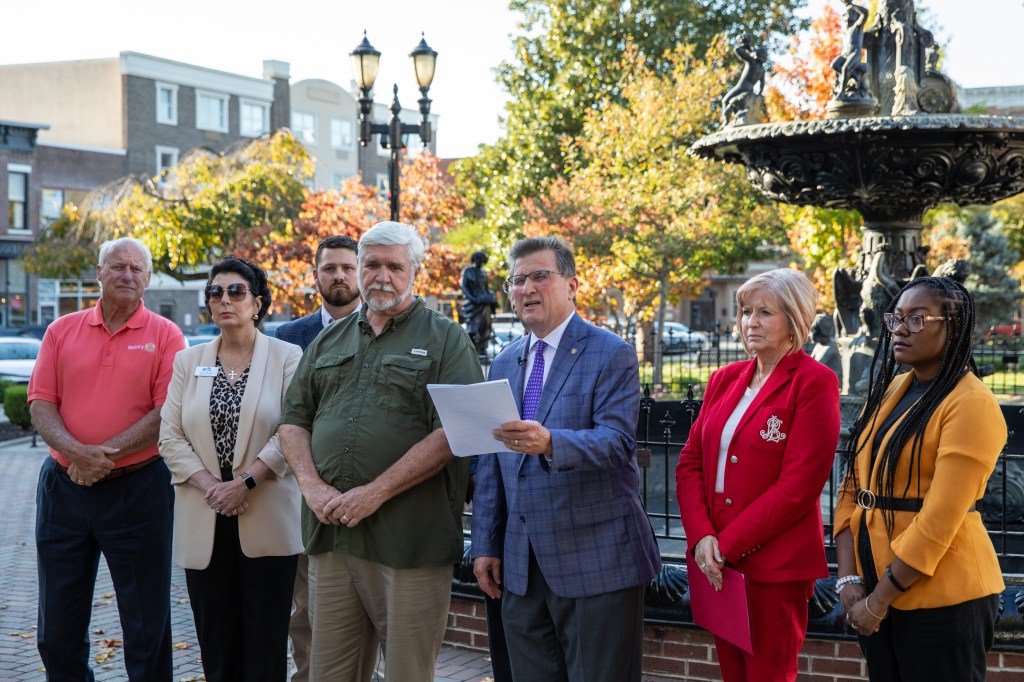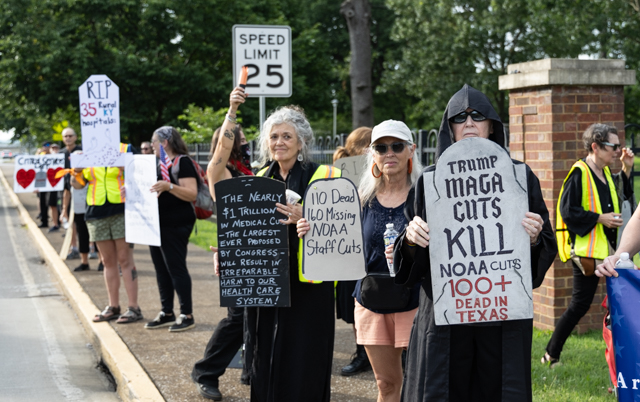With Amendment 2’s defeat, what’s next?
Published 5:48 am Saturday, November 9, 2024

- (From left) Warren County Public School board members Lloyd Williford, Amy Duvall, Adam Jackson, Garry Chaffin and Thomas Manco and Bowling Green Independent Schools board members Mike Bishop, Deborah Williams and Ciera Waller gather at Fountain Square Park on Wednesday, Oct. 30, 2024, to voice their opposition to Kentucky’s Amendment 2. (Grace Ramey McDowell/grace.ramey@bgdailynews.com)
By DAVID MAMARIL HOROWITZ
david.horowitz@bgdailynews.com
Sixty-six percent of Warren County residents who voted on Amendment 2 rejected it — conveying an opposition shared by most voters across the commonwealth, according to the Kentucky Secretary of State website.
Trending
In each of Kentucky’s 120 counties, a majority of voters opposed the constitutional amendment, according to an Associated Press map. The amendment — which would have allowed taxpayer dollars to go toward education options besides public schools, such as private school vouchers — needed a majority to pass but obtained 35% of the vote.
“I think it’s a sign that many people in the state of Kentucky value the job that public schools do for the kids of this state,” said Gary Fields, superintendent of Bowling Green Independent Schools. “They also, I think, have an understanding that there needs to be more work done by the General Assembly to fund public schools before we go down the road of taking public funds and using them for private schools.”
The General Assembly voted in March to place Amendment 2 on the ballot after Franklin Circuit Judge Phillip Shepherd last December ruled that 2022’s House Bill 9 was unconstitutional. The bill would have set up a way to fund charter schools with public dollars; in Shepherd’s ruling, he determined “a clear path” to advance that policy, a voter referendum, quoting the state constitution: “No sum shall be raised or collected for education other than in the common schools until the question of taxation is submitted to the legal voters, and the majority of the votes cast at said election shall be in favor of such taxation.”
Rob Clayton, superintendent of Warren County Public Schools, wrote that the decision shows voters’ “strong support for public education and highlights the commitment to our dedicated teachers and staff members who work tirelessly for our students.”
“We’re proud that Kentuckians recognize that adding more students to the allocation of school funding will further exacerbate the inadequacy of funding that’s already occurring,” Clayton said.
Notably, he said, WCPS educators and support staff make on average about 25% less compensation than public school employees in 2008 when accounting for inflation.
Trending
“It’s our hope that our legislative leaders finally acknowledge that these national cultural wars are not relevant to Kentucky’s public schools, and that the most effective approach to supporting all students, especially our most vulnerable students, is to reinvest in our existing public schools,” Clayton said.
Gary Houchens, a prominent supporter of the amendment, wrote Wednesday for Kentucky Today that “the defeat of Amendment 2 on the November ballot was a huge loss for Kentucky’s families. But the fight for high quality education options for every child will go on.”
“Kentucky’s education status quo, whereby affluent parents continue to enjoy education options but low- and middle-income families are stuck with whatever the local public school offers, will remain for the foreseeable future,” Houchens wrote. “But school choice advocates will not stop fighting.”
The Daily News asked local representatives if they plan to support, oppose or propose any proposal similar to Amendment 2 in the future.
State Sen. Mike Wilson, R-Bowling Green, who had voted in favor of House Bill 9 in 2022, said the General Assembly “remains dedicated to finding innovative ways to enhance public schools and support parents of public school students.”
“Our commitment to promoting excellence and safety within Kentucky’s education system remains strong,” he said.
Rep. Robert Duvall, R-Bowling Green, who had joined the House after House Bill 9, said he’ll “keep working with my fellow members in the House Majority to focus on helping Kentucky kids get the education they need to unlock their potential. We’ll continue to support public education in Kentucky.”
Duvall added that the General Assembly has provided record education funding, adjusting for inflation, these past few years.
“We’ve also passed policies aimed at improving classroom behavior, student attendance, and how we teach reading and math, as well as helping recruit and retain qualified teachers to the profession,” he said.
Fields, the BGISD superintendent, has said that although state education funding has gone up, much has needed to go toward public pensions — which the state has largely underfunded over the years. Unfunded liabilities for the public employee pension system has totaled between $40 billion and $60 billion, according to the Kentucky Chamber of Commerce; as of June 30, 2023, the Kentucky Teachers’ Retirement System’s unfunded Actuarial Accrued Liability — an estimation of the amount owed to members’ pensions after accounting for assets — totaled $17.5 billion, according to the organization’s annual report.
Meanwhile, BGISD and WCPS, like other school districts statewide, have long made do with underfunding. In August, the Daily News showed the negative impact inflation has had on the foundational legislative program for funding public education across the state, Kentucky’s Support Education Excellence in Kentucky (SEEK). The data, from the Kentucky Department of Education and the Legislative Research Commission and the consumer price index, show that when adjusted for inflation, SEEK funding has dropped substantially.






